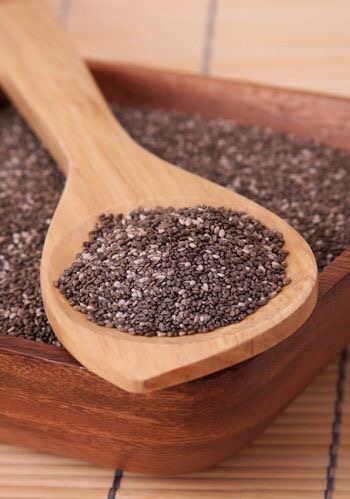So I thought I would begin with a few posts on the latest ‘it’ foods and whether they live up to the hype. First cab off the rank are chia seeds, first brought to the western world in the form of the chia pet (remember those? yep same seed!). These innocent little dots, similar in size and appearance to poppy seeds are said to be a power house food, full of omega fatty acids, fibre and protein. But how do they compare to other foods and how can you incorporate them into everyday meals without it feeling like a science experiment? Read on to find out…
The USDA nutrition table for chia seeds shows they are around 16.5% protein, nearly 31% fat and a whopping 34.4% fibre in their dry state. But it’s the micronutrients that make all the difference, of the fat content, nearly 90% is unsaturated, these are the good fats, some of which can assist in lowering LDL cholesterol levels in the blood, improving cardiovascular health.
Nutrition analysis by the FDA has also found significant amounts of many essential vitamins and minerals, including B vitamins, iron, magnesium and zinc. However, as chia is generally consumed in pretty small quantities, there are easier and decidedly tastier ways to get a similar multivitamin kick, including fresh fruit and veg.
Probably the greatest asset of chia is its water holding ability, up to 10 times their weight in water in fact. When soaked overnight, chia seeds form a gel like mass, often flavoured or mixed with cinnamon and coconut milk to make a ‘pudding’ of sorts.
The combination of high protein and fibre content, along with the water holding properties mean that chia is a great dietary ‘filler’, that’s actually from nature, no artificial sweeteners or added sugar in sight! The calorie profile means that the very few kilojoules you are taking in are quality amino acids and good fats that will keep you full between meals or instead of dessert. If you are trying to lose weight, the full feeling you get from a chia pudding will help you to ward off cravings and give you an important nutrient boost that diet yogurts or muesli bars just can’t match!
I will sign off with a word of warning, if you decide the take the plunge and give chia a go, start slowly. The water absorbing properties can continue even once in your tummy, so make sure you manage your fluid intake to avoid some serious bloating and potential temporary blockages as they make there way through the digestive system. I offer these words of caution from a position of experience.
Here’s a popular chia pudding recipe from the The Chia Co. to get you started:::
CHIA SEED PUDDINGS
By Chef Kate McAloon
Prep time
5 – 10 minutes
Total Time
2 hour refrigerate
Serves
A group
These healthy treats are great when you desire something sweet and delicious. They take very little time to prepare and are great in the mornings for a quick and yummy addition to your breakfast. Serve with fresh fruit, eggs and veggies for a nutritious start to your day.
INGREDIENTS
1 cup coconut cream or coconut milk
¼ cup Chia seeds
¼ cup honey, agave, coconut sugar or palm sugar (or to taste)
½ tsp vanilla extract (optional)
Possible flavouring options:
2 tbsp coco powder
¼ cup raspberries puree (or other fruit purees)
¼ cup lemon juice
METHOD
In a medium size bowl, mix all ingredients and add your choice of flavouring. Mix well to combine. Transfer pudding into shot glasses. Refrigerate the pudding for at least 2 hours.


